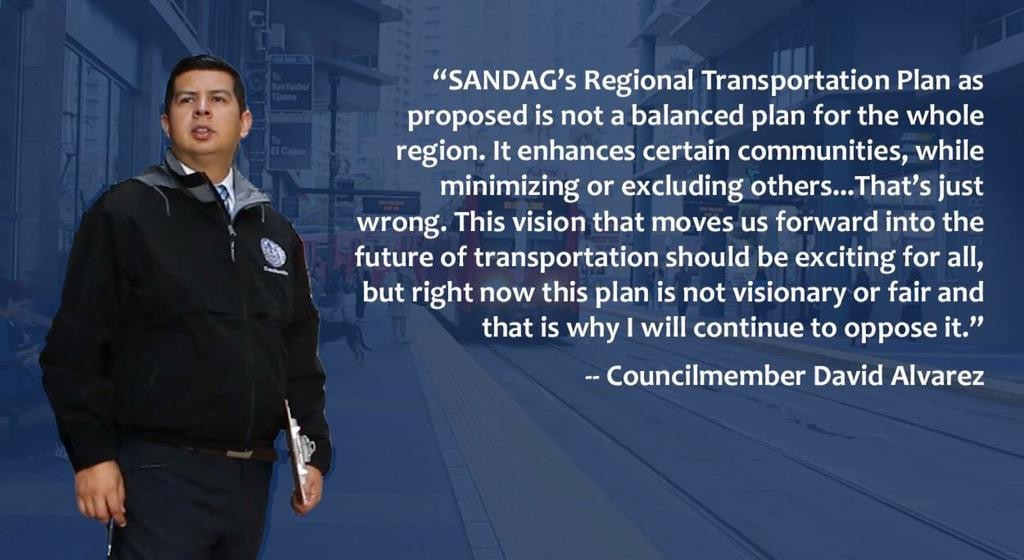News, Links, and Other Views

San Diego
- This past weekend was December Nights, the annual holiday event in Balboa Park where almost all of the main park is closed to vehicle traffic. Not surprisingly, San Diegans respond by showing up in crowds. The crowds have spawned a twitter account complaining about said crowds. (via) Maybe San Diegans aren't too enthused having all the available public land dominated by the automobile? Maybe I'm just dreaming.
- Theresa Owens got 19 years for hitting and striking a group of riders, one of whom has been injured for life. Much thanks to the District Attorney's Office for keeping on this case.
- In cool news, maybe San Diego will one day be home to a binational bike lane.
- Man Tracks Stolen Bike, Poses as Buyer to Catch Thief. Don't do this as it could lead to bad outcomes in addition to a missing bicycle. Our own SDPD has a great bait bike program where the punishments aren't punitive as much as they just serve as a deterrent. More details about the bike bait program can be reviewed in the Bicycle Advisory Committee meeting minutes from this past May. If you need another reminder to not deal with the thieves on your own, here is a reminder. These thieves have no conscience or shame. You can prevent your bike from being stolen.
- BikeSD board member and North Park resident, John Anderson, isn't impressed with North Park being considered a bike friendly neighborhood, North Park – San Diego’s Weak Excuse for a Bike Friendly Place.
- Peninsula Community Planning Board seeks to add more parks and a bicycle connection between "the Portuguese Hall to Cabrillo National Monument along Avenida de Portugal, Canon Street and Catalina Boulevard featuring additional landscaping and safe pedestrian and bicycle paths."
- In a story about the mid-city bike corridor through Talmadge, one commenter doesn't want more bike lanes. But remains curiously silent about SANDAG's plans to keep funding freeways.
- Amgen California will return to San Diego next year.
- Bicyclist in critical condition after crash on Mission Bay Drive
San Diego County
- Caltrans plans to buy part of Manchester Ave. strawberry fields for a Park and Ride. It's a miniscule part of the $6.5 billion I-5 widening plan Caltrans has cooked up despite also admitting that more roads mean more traffic.
- Many bike projects are scheduled to begin construction in the new year.
- The National City segment of implementing the Bayshore Bikeway is experiencing some headwinds
- Imperial Beach is doing a lot of bike friendly things and becoming a safer city too.
- In Coronado City Problems: the San Diego County Bicycle Coalition wrote an open letter asking for reasonableness. Coronado resident writes a letter about the bike advocate infiltration.
- In Encinitas: a reasonable letter asking for more than the status quo half measures.
- Only in Southern California, do we have a story that starts as follows, "[o]ne of Carlsbad’s busiest coastal parking lots...". Fear not since the story is a few weeks old and so the parking lot is back in business.
- In another part of Carlsbad, plans for a bike park and more were brought up at a recent community meeting.
- El Camino Bike Shop is collecting used bicycles for a Holiday Basket program
- At least one County Supervisor, Greg Cox, gets it. Here is a great profile about him.
- City of Oceanside has installed speed monitors, relying on driver's behavior instead of proven design to ensure road safety.
- Painted lines don't protect bicycle riders from drivers from driving into them. Hope the three riders who were struck are back on the bike soon.
- Annika Walden of Encinitas wants safer bike lanes. Darius Degher pens an ernest essay on how bicycling will save us.
- Carlsbad's Thomas Arnold gripes about unused bike racks. Maybe instead of complaining, he could consider riding his bicycle and locking his bike to said racks and inspire his neighbors and friends or give him a parking space to someone who cannot ride a bicycle?
- Carlsbad may get roundabouts.
- Twelve-year old Oceanside boy killed in collision with pickup while riding his bike to school. His family needs help. Residents say the stretch where he was killed is unsafe.
- For the first time, the state is asking local agencies to use traffic safety grant money to help reduce the rising number of pedestrians and cyclists who are being injured or killed on California’s roadways
- Cyclist badly injured by Escondido hit-run driver
California
More news next week. Putting this together took a while.
Today’s the day! San Diego Cyclists Need Your #GivingTuesday Support
This is it. It’s finally #GivingTuesday. Please take a moment to support BikeSD.
Every day that you ride your bike in San Diego, there is an organization that has your back. On every dangerous street, and in the face of every parking-obsessed politician, BikeSD is advocating for you, your safety and your happiness.
Today is our greatest chance to raise BikeSD’s budget for the next year. #GivingTuesday is a celebration of generosity where people support the causes they care about across America. Please take a moment to support BikeSD for #GivingTuesday.
I love to ride my bike, too. Four years ago, I started BikeSD because I knew in my heart that San Diego could be a better place to ride a bike. Our streets can be less frightening, more safer, full of more cyclists. Together, you and I can get there. Thank you for your support.
Samantha Ollinger
Executive Director
P.S. Please take a moment to support BikeSD for #GivingTuesday. It’s the most important fundraising event of the year for San Diego cyclists, and you’re a critical part of whether or not today is a success.
How Can BikeSD Make a Dent in Income Inequality? Through Advocacy and Embracing Equity
This is a bit of a philosophical post and thus a little lengthy. I’ll be happy to expand on this post in subsequent posts if you want me to. Just leave a comment or send me an email.
Last year, Councilmember David Alvarez appointed me to represent his council district, District 8, at the city’s Bicycle Advisory Committee. It was an incredible honor and a challenge, because I live in Council District 9, not 8. In an attempt to understand the district, the needs of the community, and the challenges I would be dealing with, I met with one of Alvarez’s staffers for coffee one morning. At the meeting, the staffer told me, in no uncertain terms, that bike infrastructure was not necessarily a priority for the district. I was a bit blindsided and it has taken me almost an entire year to understand what she meant when she gave me the low-down on District 8. This post is an attempt to explain that understanding.
First, here is a little personal history, which is relevant for this story. I am an immigrant, brown-skinned woman who co-founded a bike advocacy organization in San Diego. For those of you whose first contact with bike advocacy is BikeSD, you may not find anything unusual about that. However, nationally, the bike advocacy movement is struggling with trying to broaden its scope both within its leadership and within its advocacy focus. Historically, the bike advocacy movement has been dominated by men, often middle-aged, and almost always white, sometimes even with racist historical baggage that is hard to dispose. There is nothing inherently insidious with the movement’s historical representation in and of itself, both because of historical realities and also because of how the oil and the automobile industries have dominated the American life experience and culture. So, standing up for something that has never benefited from either policy or funding priorities outside of a curious interest or the focus of childhood play almost seems bizarre. But, bicycling isn’t just a hobby. It is a very simple solution for many complex problems.
Solving problems that are complex and varied with many underlying root causes cannot be addressed by any one single or ethnic group.
Policy wins, in a period of scarce resources and strange media rhetoric in a crowded field of numerous competing priorities, can be extremely challenging. How can one expect the basic amount of respect for a cause when jokes about killing your constituency is both commonplace and tolerated?

Around the time BikeSD was founded in 2012, many advocacy organizations began to realize the huge missing representation within their own respective organizations. Women were rare birds in bike advocacy leadership. There was also a glaring omission of any ethnic or racial minority group at the top levels (and often even at the staff levels) of bike advocacy organizations. So not only was BikeSD founded with the intention of changing San Diego’s culture that was centered around the automobile, but the organization was created to also push the envelope of what it meant to be part of an organization that focused on equality of sexes and was inclusive and fearless in challenging the status quo. We wanted the organization to be a public platform for every voiceless resident. My vision, that my board, advisors, and supporters have bought into, was to create a city where it was not just white guys in spandex riding around in circles at the Velodrome. Instead, we would work together to create a city where our differences, while external, could be celebrated and become learned experiences for everyone. We envisioned a city where our streets could be public gathering spaces where we could share ideas, converse, and enjoy, while moving through it comfortably and safely. We wanted BikeSD to be a platform to address historically broken promises by being an organization that would be willing to stand up to and challenge the status quo.
Bike infrastructure isn’t important.
This may sound strange or even seem like a heretical statement to be making on behalf of an organization whose entire mission is ostensibly to advocate for bike infrastructure. However, our organizational focus on equity should provide a hint to the deeper meaning and purpose of our existence. This doesn’t mean that we want everyone to “share the road” with multi-ton vehicles on 45mph roads by riding on sharrows. But, bike infrastructure also cannot be the only solution that we advocate for to the detriment of the lives and dignity of communities and neighbors that have always been forgotten.
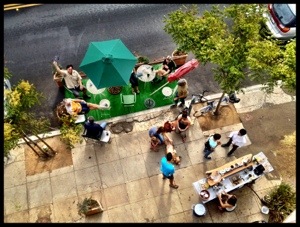
Infrastructure, in its bluntest terms, means funding. Money. Dinero. Cold hard cash. So by advocating for bike infrastructure, we are advocating for reallocating funding, away from driving and away from design features that isolate, harm, and kill us—both metaphorically and literally. Are parking lots, with hundreds of parked cars, thriving centers where great minds congregate to solve problems and innovate? On the other hand, how many ideas have been hatched on group rides, on solo rides, in coffee shops, or at the local parklet? By advocating to reallocate funding we want to work to connect communities and create people-centric havens that not only make bicycling safer, but also make our cities more livable and humane. We envision a city where walking is less stressful and driving is less dangerous. Bike infrastructure is the clarion in the coalmine for a better life. But more importantly, reallocating funding allows everyone to partake in the riches that our society has for too long failed to deliver to our most marginalized and neglected communities.
Understanding why bike infrastructure doesn't matter (as much) in underserved communities
So back to that coffee meeting with the Alvarez staffer. Barrio Logan is a community in District 8. Last year, the community suffered a devastating defeat when business interests lobbied to crush and destroy a community supported Community Plan that would have given the residents the very basic dignity of not having to live alongside toxic industries. This is a community where residents have to regularly deal with toxic dumping that affects not only the quality of life, but their very existence. This is in addition to living alongside a gigantic bridge that serves as a daily visual reminder of the sheer callousness of how little policy makers think of their community. In this reality, where exactly do bike lanes (protected or painted) belong in the list of community priorities?
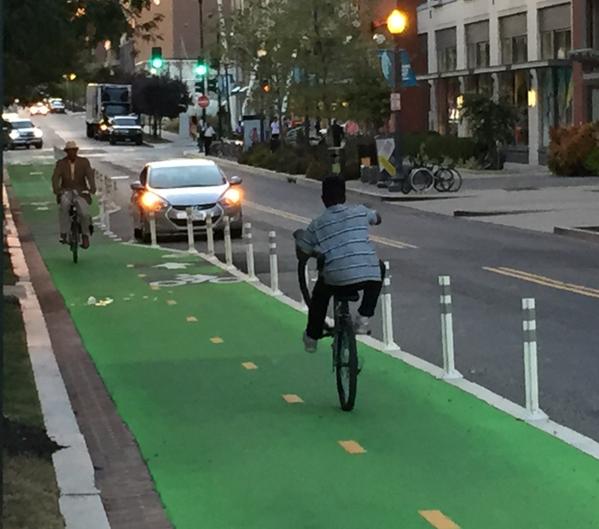
Earlier this week, our City Council unanimously supported a council resolution to adopt a Vision Zero resolution—a commitment of sorts to work on reducing all traffic fatalities to zero within the next decade. While a post on that is forthcoming, addressing Vision Zero appropriately also includes a focus on addressing equity. I live in City Heights where cases of police overreach have been documented, as it has been elsewhere. So amongst the six E’s, is Enforcement an appropriate solution to making sure Vision Zero is a success? Granted, not everyone within law enforcement are untrustworthy and bad people, but when community interactions with law enforcement has only resulted in the breakdown of trust, it is possible that enforcement of minor roadside infractions may not be the most judicious use of our valuable public dollars. Is penalizing jaywalking the appropriate solution if a jaywalker was killed previously? Or would a road diet, alongside speed reductions and the creation of a mid-block crossing, be a better solution?
Invisible Cyclists
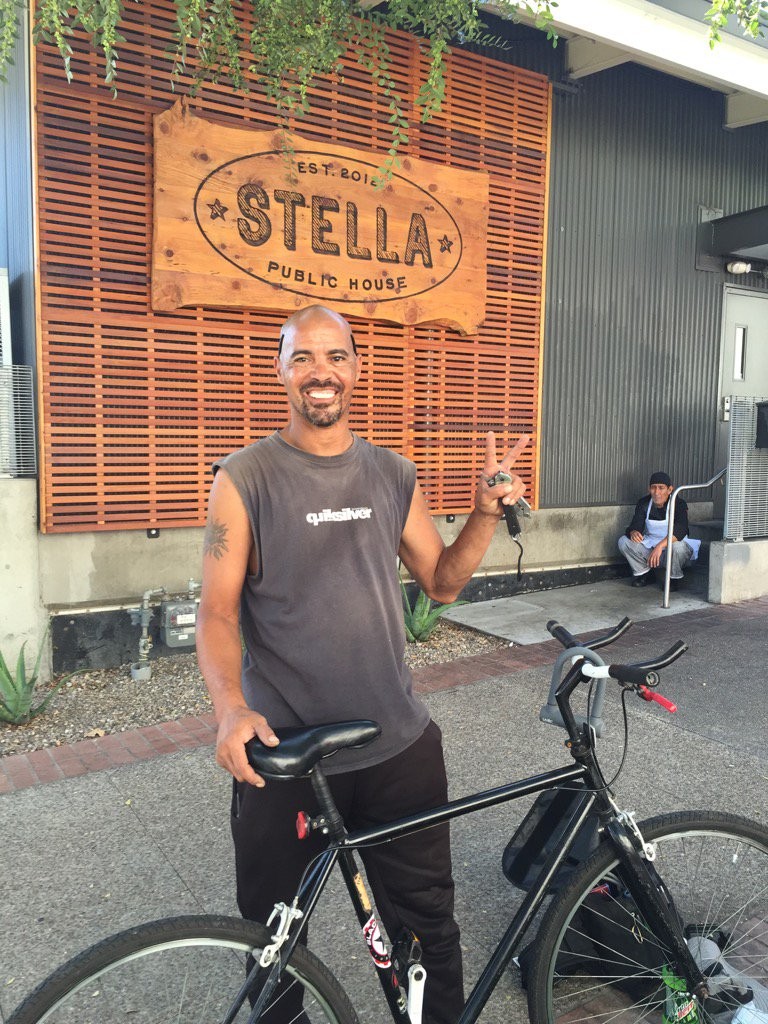
A group of riders that exists in every community but remains hidden are invisible cyclists. They are your local service workers: the cashier at your fast food restaurant, your janitor, and even the friendly homeless panhandler who straddles the median on Balboa Avenue. These people don’t have a choice and use a bicycle as the most cost effective way of getting around, just like I did many years ago when I was working five jobs and trying my best to get through college (an endeavor that took nearly a decade to accomplish). Bike lanes don’t feature into their reality and it didn’t for me either when I was struggling to make rent and get an education. And, neither do community meetings where uneducated rubes selfishly fight against any sane solution that would make our streets safe for every person.
So does that mean bike lanes are bad or unwanted? Absolutely not. But in a community where people would like to live in homes free of mold and cockroaches, bike lanes aren’t on a top priority list, especially if they generally allude to an even more unattainable and pricier life. This disconnect has been studied and documented by a friend and researcher, Dr. Adonio Lugo, some of which was expanded upon in a recent Governing article.
What's Next?
The elephant in San Diego’s living room remains the automobile. The relentless quest to prioritize and elevate the automobile’s dominance has destroyed many San Diego neighborhoods, as well as, killed and injured countless lives. There is a way out and the only way forward is to move away from the automobile. But, to do that, we need everyone on board. Changing a culture isn’t easy, but neither is witnessing growing societal disparities where our own friends, neighbors, and service workers are denied a voice at the table of public resources.
So remember that while bike infrastructure is a solution, and a valuable one at that, sometimes it’s not a priority for other more pressing needs. The challenge is to dissect and understand the real concerns that cause greater disparity from ones that don’t. Stay tuned for more on this subject.
This was a long post to delve into. In future blog posts this post will be expanded to include topics such as:
What are some things that other bike advocacy organizations have done to help bridge the gap?
What exactly are some of the things BikeSD plans to do?
What can I, as a volunteer do to help bridge the gap?
----
Stay tuned for how we, with your help, intend to address those questions. In the meantime, hope the post above gave you something to think about and be motivated enough to get involved more meaningfully as we expand and strenghten on the work that you have signed on to support. We are a non-profit organization, so your financial support today does help make for a better San Diego tomorrow.
Today: Mayor Faulconer Forgoing Vote on $200 Billion Regional Transportation Plan
 As Voice of San Diego reports,
As Voice of San Diego reports,
Mayor Kevin Faulconer has punted an opportunity to vote on $200 billion in spending on an issue central to his legacy.
That's right, with a $200 billion dollar plan on the table where our city has a 40% stake in - our own mayor has opted to not bother with a vote. He is sending his alternate, Councilmember Zapf who will be voting to support the plan. Yes, despite the plan proposing to implement over 1,700 additional miles of freeways, the mayor still seems to think this is a great plan. Never mind the "Transit First" resolution that the city of San Diego Council passed in 2011 that the plan is failing to implement.
If you read SANDAG staff responses to various organization's requests to prioritize bicycling and walking or implement "transit first" (prior to freeways), the responses repeat one line over and over: that SANDAG does not have land use authority and thus the Regional Transportation Plan cannot dictate land use - or what can be done with land. That is true, SANDAG as a regional planning agency does not have land use authority. However, the SANDAG board is comprised of elected officials from around the county who are ostensibly elected to represent the citizens in their jurisdiction. These elected officials vote on land use matters specific to their jurisdiction. For example, the San Diego City Council voted to give land to Deco Bike Share so the company could place advertisements on public land and raise revenue to support their bike share operations. These elected officials, like Mayor Kevin Faulconer (or Councilmember Lorie Zapf) and Councilmember Todd Gloria are expected to carry out the will of their electorate who expect their electeds to vote on a plan that is a good use of public taxpayer dollars.
The current plan, scheduled for adoption today, is an update of the 2011 plan. The plan scheduled to be adopted today still has all the road projects from 2011. The transit projects from 2011 have been replaced with cheaper projects. In other words, if you thought hoping for an empty bus rack was a temporary problem, SANDAG plans to make this permanent.
While the plan will get adopted today with the vast majority of the board ignoring the overwhelming majority of public speakers who will urge them to vote against the plan, I know one local leader will listen to his constituents and oppose the plan, Councilmember David Alvarez. As he stated on twitter yesterday, "Waiting 35 years for progress in bike/transit/pedestrian infrastructure is not an option."
Thank you Councilmember Alvarez, for being a true leader.
SANDAG’s Gary Gallegos: “Transit is not going to work for every person in the region”
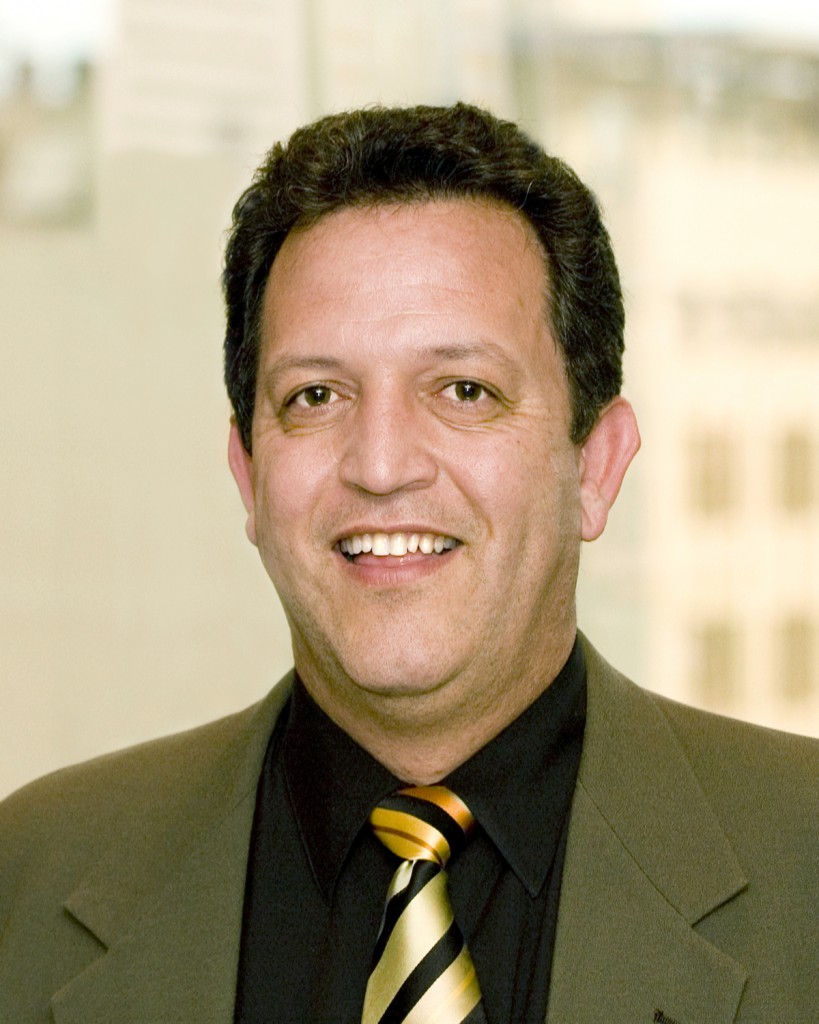
“We are not going to put everybody on a bike, we are not going to take everybody out of their car, transit is not going to work for every person in the region.” - Gary Gallegos, executive director of SANDAG, San Diego’s Metropolitan Planning Organization. January 8, 2014.
“the SANDAG plan is to spend more than half the $204 billion on mass transit, adding five new Trolley lines, 32 new rapid bus lines and 275 miles of new bikeways, as well as 160 miles of freeway lanes intended to help transit and encourage carpools and van pools. The net effect would be to reduce county greenhouse gas emissions by considerably more than state targets.” - UT Editorial Board
I don’t know what sort of drugs the UT Editorial Board is consuming, because if they bothered to read SANDAG’s own analysis they would have seen that implementing the existing Regional Transportation Plan (scheduled for a SANDAG board vote on October 9th) in its current form is going to increase the region’s greenhouse gas emissions. Check out the below graphic for a visual, taken right from SANDAG’s own documentation
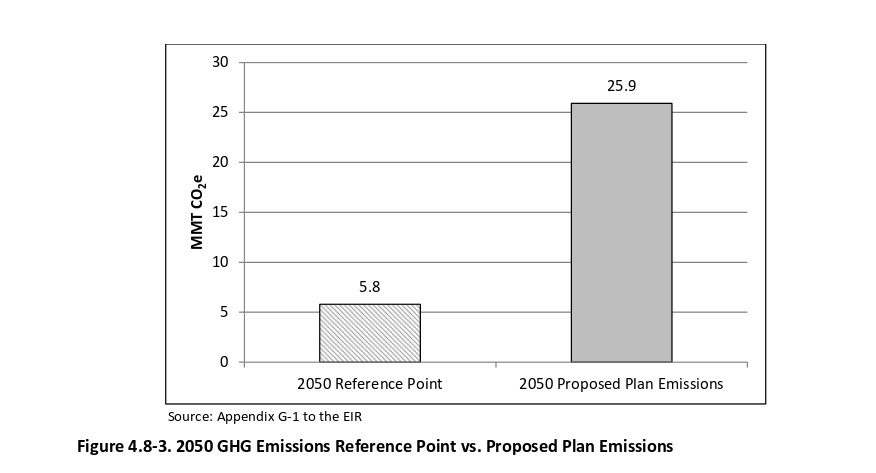
SANDAG’s own analysis shows an increase in vehicle miles travelled between now and 2050, which will increase greenhouse gas emissions. The analysis goes on to state that in order to meet the state goals of reducing the region’s greenhouse gas emissions, SANDAG needs to encourage “more compact development than a multiple dense cores scenario, further substantial increases in the cost of driving, and further substantial transit service improvements,“
This same document by SANDAG staff discusses induced demand, in that increasing roadway capacity induces driving (and thus more greenhouse gas emissions). The document also points out that congestion is good because it “may then lead to longer trips and a change in mode.” Between 2012 and 2050, SANDAG’s own analysis shows that they are planning to increase freeway capacity by an additional 1, 757 miles of freeways.
The implementation of the entire 2050 plan is divided into three phases summarized below in the table by expenditures (in millions)
| Project Categories | 2014-2020 | 2021-2035 | 2036-2050 | Total |
| Transit | $6,161 | $27,756 | $66,999 | $100,916 |
| Managed Lanes and Highway Improvements | $4,070 | $16,200 | $37,041 | $57,311 |
| Local Streets and Roads | $3,180 | $8,573 | $14857 | $26,610 |
| Debt Service | $863 | $3,834 | $4,477 | $9,174 |
| Active Transportation/Systems Management/Demand Management | $1,107 | $3,459 | $4,846 | $9,412 |
To SANDAG’s credit, Active Transportation investments have been increased to $4.9 billion - no small amount. But if Uptown was any indication of how future projects will proceed, the future for walking and bicycling looks very bleak in that projects will continue to be implemented in a hodge podge manner, watered down over the smallest of whining over loss of curbside parking instead of implementing proven methods that actually connects communities and addresses the barriers to walking and bicycling and transit use in the region.
Within the 2050 RTP Update, SANDAG is proposing to leverage a little over $98 billion in local funds to receive $68 billion in state funds and $36 billion in federal funds. A cursory glance at the state and federal funds scheduled to come into the region seems to indicate that these funds can be used toward providing increased transportation choices like dedicated rail transit which can also increase bicycle ridership, but the board (our own elected officials) has - at Gallegos’ behest - continued to prioritize freeways over transit and active transportation projects.
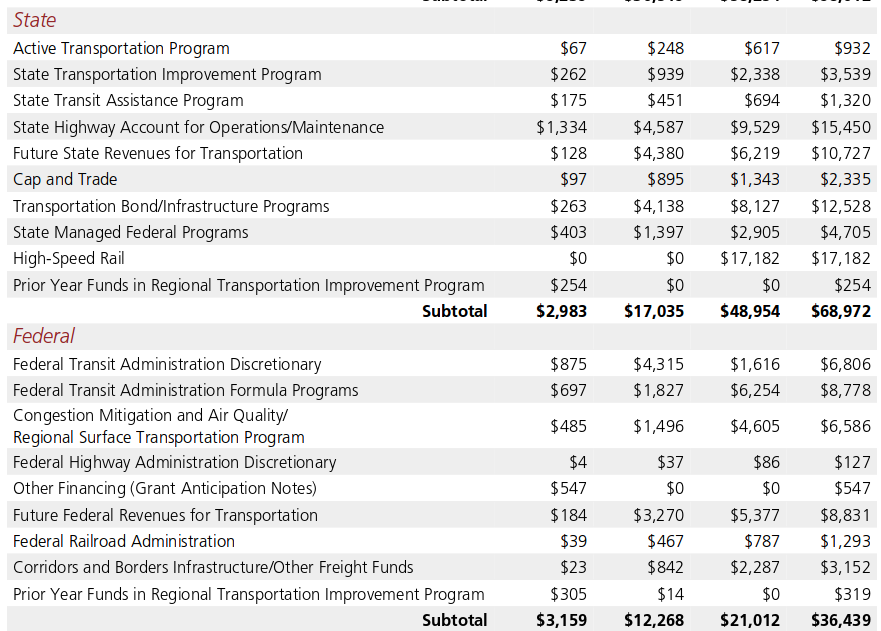
I wanted to take a cursory look at the transit investments however. Out of the $100.9 billion devoted to transit, $17 billion is allocated toward the California High Speed Rail that wouldn’t be in operation until the later part of the plan’s implementation. Further more, $39 billion is for transit operations and given the region’s high farebox recovery rates, we have proof that transit pays for itself more than highway projects do. In the first phase of the plan’s implementation (2014-2020), $2.1 billion (out of the total $15.4 billion) is being spent on transit: the Mid-Coast Trolley and double tracking the Coaster. The rest of the money is being spent on Rapid Buses and a Airport Shuttle that sounds like it was designed by individuals who haven’t experienced airport transit systems in nearly every major city in the country.
To summarize, SANDAG’s own plan won’t meet the governor’s order to reduce greenhouse gas emissions. SANDAG continues to build freeways and increase road capacity for drivers while failing to push for either a means to pay for driving use or provide an alternative that would induce San Diegans to shift travel modes.
So what is the SANDAG board going to adopt next week? More of this:
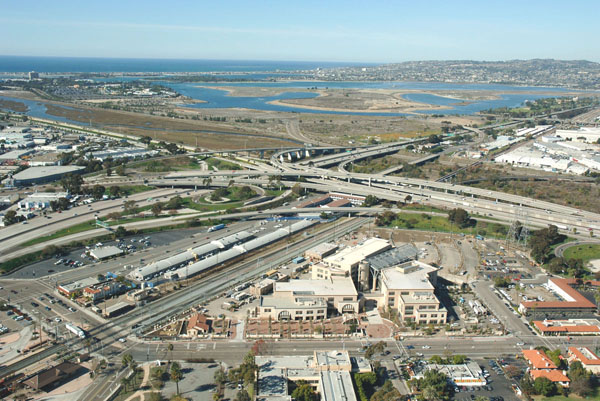
and less of this:

Change to a more sustainable, healthier future is well within San Diego’s reach. Changing behaviour by redesigning our region’s transportation networks for the long term sustainability is possible. It’s just too bad our elected leaders aren’t willing to be leaders.

